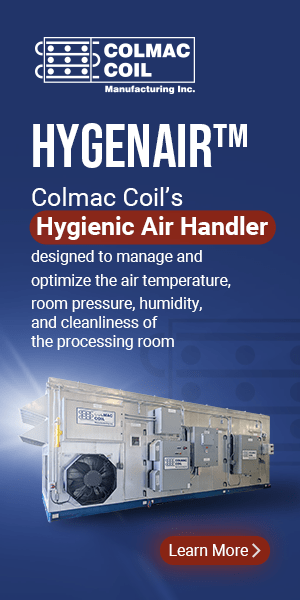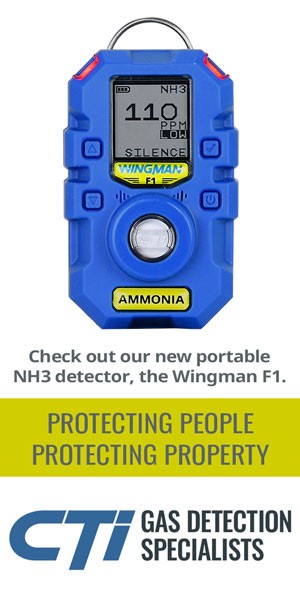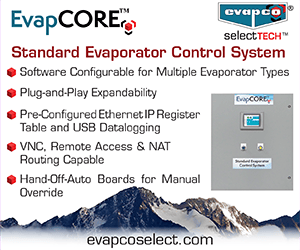The 2018 and 2021 Codes: Where We Are & Where We Are Headed (Part 2)
JEFFREYM. SHAPIRO, P.E., FSFPE
Part 1 of this article presented IIAR’s many successes in changing the 2018 editions of model mechanical, building, fire and electrical codes in working with FM Global to update their recommendations for facilities with ammonia refrigeration.Part 2 provides a preview of IIAR’s proposed changes to ASHRAE 15 and the 2021 model codes.
Some changes in code text in this article are shown in “legislative format” to indicate deleted text (strike-out format) and new text (underline format) for clarity.
2021 IMC
1101.1 Scope. This chapter shall govern the design, installation, construction and repair of refrigeration systems that vaporize and liquefy a fluid during the refrigerating cycle. Refrigerant piping design and installation, including pressure vessels and pressure relief devices, shall conform to this code. Permanently installed refrigerant storage systems and other components shall be considered as part of the refrigeration system to which they are attached.
1101.1.1 Refrigerants other than ammonia. Refrigerant piping design and installation, including pressure vessels and pressure relief devices, for systems containing a refrigerant other than ammonia shall comply with this chapter and ASHRAE 15.
1101.1.2 Ammonia refrigerant. Refrigeration systems using ammonia as the refrigerant shall comply with IIAR 2, IIAR 3, IIAR 4 and IIAR 5, and shall not be required to comply with this chapter.
1101.6 General. Refrigeration systems shall comply with the requirements of this code and, except as modified by this code, ASHRAE 15. Ammonia-refrigerating systems shall comply with this code and, except as modified by this code, ASHRAE 15, IIAR 2, IIAR 3, IIAR 4 and IIAR 5.
Discussion: Similar to the 2018 UMC and the tentative acceptance of IIAR’s 2021 NFPA 1 proposal (see below), the 2021 edition of the IMC will delete regulations for ammonia refrigeration in the in favor of referencing IIAR standards. The changes above show the core revision, which defers to IIAR standards 2, 3, 4 and 5. Additional changes, which are not shown here, are also proposed to remove all other references to ammonia refrigeration in Chapter 11.
2021 IFC
605.1.2 Ammonia refrigeration (standards). Refrigeration systems using ammonia refrigerant and the buildings in which such systems are installed shall comply with IIAR-2 for system design and installation, IIAR 6 for maintenance and inspection, and IIAR-7 for operating procedures. Decommissioning of ammonia refrigeration systems shall comply with IIAR 8, and engineering practices for existing ammonia refrigeration systems shall be in accordance with IIAR 9.
Discussion: References adopting IIAR 6 and IIAR 9 were approved for inclusion in the 2021 edition of the IFC, provided that the standards are completed by a December 2020 deadline, which IIAR expects to meet.
605.10 Emergency Pressure Control System. Permanently installed refrigeration systems in machinery rooms containing more than 6.6 pounds (3 kg) of flammable, toxic or highly toxic refrigerant or ammonia shall be provided with an emergency pressure control system in accordance with Sections 605.10.1 and 605.10.2.
Discussion: The original concept of emergency pressure control systems (EPCS) was to serve as a substitute for cross-over valves in manual emergency control boxes. Emergency control boxes were previously required only by the Uniform Fire Code (a model code that preceded the International Fire Code), with an expectation that ammonia could be transferred to another pressure zone or released to a water tank, treatment system or atmosphere to reduce system pressure in the event of a building fire that exposed the system to high temperatures.
Because the original focus of the EPCS concept was large, stationary equipment that would be found in a machinery room, IIAR considered it appropriate to submit this proposal to revise the requirements in a way that makes it clear that EPCS are not required for portable equipment or equipment located outdoors.
The change has been approved for inclusion in the 2021 edition of the IFC.
605.12.4 Ammonia Refrigerant (discharge). Systems containing more than 6.6 pounds (3 kg) of ammonia refrigerant shall discharge vapor to the atmosphere in accordance with one of the following methods:
- Directly to atmosphere where the fire code official determines, on review of an engineering analysis prepared in accordance with Section 104.7.2, that a fire, health or environmental hazard would not result from atmospheric discharge of ammonia.
- Through an approved treatment system in accordance with Section 605.12.5.
- Through a flaring system in accordance with Section 605.12.6.
- Through an approved ammonia diffusion system in accordance with Section 605.12.7.
- By other approved means.
Exception: Ammonia/water absorption systems containing less than 22 pounds (10 kg) of ammonia and for which the ammonia circuit is located entirely outdoors.
Discussion: The subject of refrigerant discharge from pressure relief valves (PRV) has been continuously evolving over the past 20+ years. From a default of having to discharge releases into large water diffusion tanks, previously required by some fire codes, to today’s more performance oriented approach that permits atmospheric discharge in some cases, the industry has gained significant flexibility in venting options.
The proposed changes to Item 1 above continue this evolution by reducing some unnecessary barriers to atmospheric PRV discharge outlets. Inclusion of the word “engineering” has unnecessarily suggested that the referenced analysis must be performed by a licensed engineer, precluding the use of other qualified individuals.
Also, “fire” and “environmental” have been eliminated as criteria to be evaluated in the analysis. Looking first at flammability, ammonia’s lower flammability limit is in the range of 160,000 ppm (16% in air), and it becomes too rich to burn in the range of 250,000 ppm or more (25% in air).
The difficulty of achieving ammonia ignition in an outdoor environment is recognized by UN/DOT, which does not classify ammonia as flammable for shipping purposes. Likewise, achieving a stable mix between the upper and lower flammable limit concentrations in open air as a result of vent-release scenarios isn’t reasonably possible.
With respect to environmental analysis, ammonia is a natural refrigerant consisting of nitrogen and hydrogen, which are readily dissipated into the atmosphere upon release from a PRV outlet. While the release may be noxious, there is no basis for predicting that ammonia vapor released from a vent pipe into open air will harm the environment.
The change has been approved for inclusion in the 2021 edition of the IFC.
906.1 Portable Fire Extinguishers:
906.1 Where required. Portable fire extinguishers shall be installed in all of the following locations (only Item 1 is shown because that is the only item affected by IIAR’s proposal):
- In new and existing Group A, B, E, F, H, I, M, R-1, R-2, R-4 and S occupancies.
Exceptions: (only Exception 3 is shown because that is the only item affected by IIAR’s proposal):
- In storage areas of Group S Occupancies where forklift, powered industrial truck or powered cart operators are the primary occupants, fixed extinguishers, as specified in NFPA 10, shall not be required where in accordance with all of the following:
- Use of vehicle mounted extinguishers shall be approved by the fire code official.
- Each vehicle shall be equipped with a 10-pound, 40A:80B:C extinguisher affixed to the vehicle using a mounting bracket approved by the extinguisher manufacturer or the fire code official for vehicular use.
- Not less than two spare extinguishers of equal or greater rating shall be available onsite to replace a discharged extinguisher.
- Vehicle operators shall be trained in the proper operation, use and inspection of extinguishers.
- Inspections of vehicle mounted extinguishers shall be performed daily.
Discussion: In large storage warehouses, such as cold storage facilities, where the occupants are primarily riding on powered industrial trucks, it makes more sense to provide suitable extinguishers on vehicles, as opposed to distributing them in fixed locations throughout a warehouse. Extinguishers on the vehicle are more readily accessible to the operator, which improves the speed of deployment, and this allowance also offers a way to avoid maintenance requirements associated with fixed fire extinguishers in refrigerated storage areas.
The change has been approved for inclusion in the 2021 edition of the IFC.
2021 NFPA 1
Chapter 53 Mechanical Refrigeration:
53.1* General.
53.1.1 Applicability.
53.1.1.1* Refrigeration unit and system installations having a refrigerant circuit containing more than 220 lb (100 kg) of Group A1 or 30 lb (13.6 kg) of any other group refrigerant shall be in accordance with Chapter 53 and the mechanical code.
53.1.1.2 Temporary and portable installations shall be exempt from the requirements of this chapter when approved.
51.1.1.3 Ammonia Refrigeration Ammonia refrigeration systems shall be exempt from the requirements of this chapter, other than Sections 53.1.2 and 53.1.3.
53.1.2 Permits and Plans.
53.1.2.1 Permits, where required, shall comply with Section 1.12.
53.1.2.2 Plans and specifications for devices and systems required by this chapter shall be submitted to the AHJ for review and approval prior to installation.
53.1.3 Reference Codes and Standards.
53.1.3.1 Refrigeration systems using a refrigerant other than ammonia shall be in accordance with ASHRAE 15 and the mechanical code.
53.1.3.2 Refrigeration systems using ammonia as a the refrigerant shall also comply with ANSI/ IIAR 2, Standard for Equipment, Design and Installation of Closed-Circuit Ammonia Mechanical Refrigerating Systems IIAR 6, IIAR 7, IIAR 8 and IIAR 9.
Discussion: Similar to the 2018 UMC and the tentative acceptance of IIAR’s 2021 IMC proposal, NFPA 1 is poisedto delete regulations for ammonia refrigeration in the 2021 edition in favor of referencing IIAR standards. The changes above show the core revision, which states that only the applicable requirements in Chapter 53 will be for permits and to follow IIAR’s standards 6, 7, 8 and 9 (pending final completion of IIAR 6 and 9). Additional changes, which are not shown here, are also proposed to remove all other references to ammonia refrigeration in Chapter 53.
The NFPA 1 Technical Committee recommended this change for approval at their meeting in May 2018, but final acceptance will be subject to additional review pending completion of the public comment period.
2019 ASHRAE 15 (ADDENDUM A TO ASHRAE 15 2016 EDITION)
2. SCOPE
2.1 This standard establishes safeguards for life, limb, health, and property and prescribes safety requirements.
2.2 This standard applies to:
- the design, construction, test, installation, operation, and inspection of mechanical and absorption refrigeration systems, including heat-pump systems used in stationary applications;
- modifications, including replacement of parts or components if they are not identical in function and capacity; and
- substitutions of refrigerants having a different designation.
2.3 This standard shall not apply to refrigeration systems using ammonia (R-717) as the refrigerant.
Informative Note: See ANSI/IIAR Standard 2 for systems using ammonia (R-717).
Discussion: For decades, IIAR 2 has served as a companion to ASHRAE 15 for regulation of ammonia refrigeration systems, providing supplemental requirements that are applicable only when ammonia is used as the refrigerant. That approach changed upon publication of the 2014 edition of IIAR 2, which was written to serve as a comprehensive, independent document that can be applied without reliance on supplemental provisions in ASHRAE 15, fire codes or mechanical codes.
Given that IIAR 2 no longer relies on ASHRAE 15, IIAR submitted a proposed Addendum A to the 2016 edition of ASHRAE 15 to remove ammonia systems from the scope of that standard and delete all ammonia-specific requirements from the standard.
The key part of this addendum, shown above, is the addition of a new Section 2.3, which exempts ammonia systems. In addition, an informational note has been added, which points to IIAR 2 for ammonia systems. This pointer was not allowed to be included directly in the code text because ASHRAE policy does not permit mandatory references to non-ASHRAE standards.
Following two public reviews, Addendum A was approved by the ASHRAE 15 technical committee and has been issued as an official addendum to the 2016 edition of ASHRAE 15. The changes will be directly integrated into the text of the 2019 edition.
In summary, IIAR’s longstanding commitment to consolidating industry regulations, with an emphasis on eliminating conflict and overlap, produced significant results in the 2018 code editions and will show further success when the 2021 model codes are published. In addition, having ASHRAE 15 defer to IIAR standards for regulation of ammonia represents a landmark achievement for the ammonia refrigeration industry. The last major challenge in IIAR’s initiative to make IIAR standards the “one stop shop” for ammonia refrigeration regulations will be the International Fire Code. That hurdle is on our agenda for the 2024 IFC code development cycle.
IIAR’s accomplishments in the model codes and standards arenas are directly attributable to the hard work and dedication of the many volunteers who have contributed to IIAR’s Standards Committee and the now-retired Code Committee. These efforts are always looking for new talent, and if you were interested enough in codes and standards to read this article and haven’t yet participated, you’re a good candidate for getting involved. Time to contact IIAR and let them know you’re ready to jump in!













